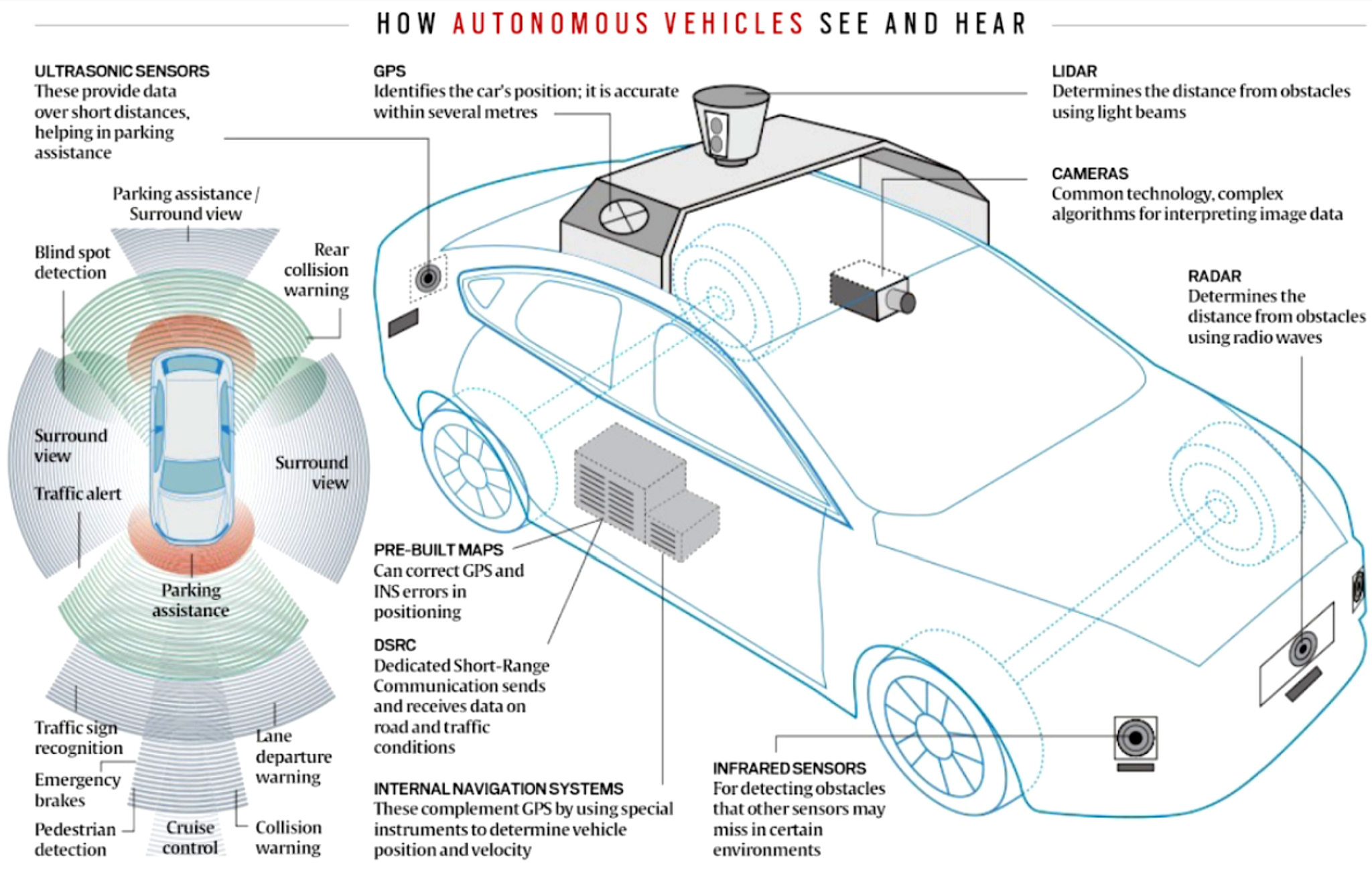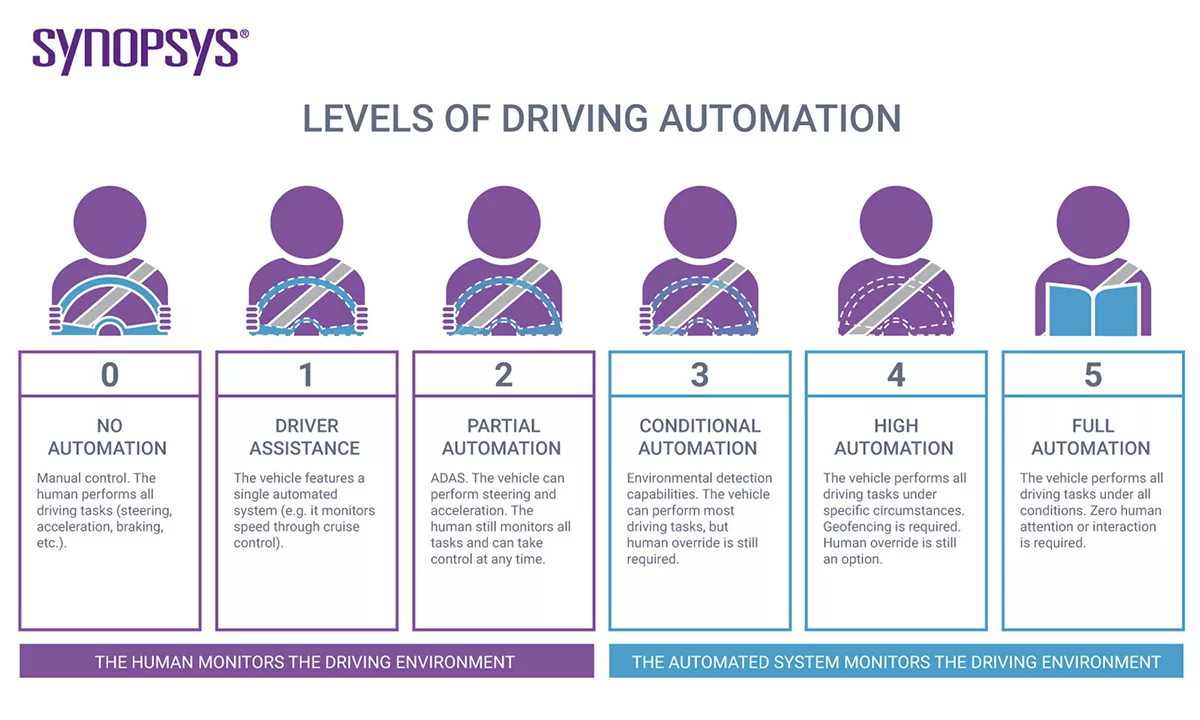Science & Technology
Demand for Advanced Driver Assistance Systems
- 27 Jan 2024
- 6 min read
For Prelims: Advanced Driver Assistance Systems, Autonomous Driving
For Mains: Landscape of Self-Driving Cars in India, Automation of Transport and challenges
Why in News?
As autonomous driving gains momentum globally, India emerges as a surprising yet significant market, with a surge in demand for Advanced Driver Assistance Systems (ADAS).
What is Advanced Driver Assistance Systems (ADAS)?
- About:
- Advanced driver assistance systems (ADAS) can be defined as in vehicle digital technologies that help drivers in routine navigation and parking without fully automating the entire process but instead leveraging computer networks to enable more data-driven and safer driving experiences.
- ADAS systems use sensors, cameras, and radar to monitor the environment around a vehicle.
- They can provide active safety information, driving interventions, and assistance with parking.
- The goal of ADAS is to reduce the incidence and severity of automotive accidents that cannot be avoided so that deaths and injuries can be prevented.
- These devices can give important data about traffic, road closures and blockages, congestion levels, advised routes to avoid traffic, etc.
- Advanced driver assistance systems (ADAS) can be defined as in vehicle digital technologies that help drivers in routine navigation and parking without fully automating the entire process but instead leveraging computer networks to enable more data-driven and safer driving experiences.
- Popular ADAS Features:
- The ADAS suite includes features such as automatic emergency braking, forward collision warning, blind spot collision warning, lane-keeping assist, adaptive cruise control, and more.
- Reasons for Surge in Demand in India:
- Progressive Democratisation:
- India is witnessing a progressive democratisation of autonomous driving tools. Car manufacturers are increasingly offering ADAS as standard features on mid-segment vehicles, contributing to the heightened demand for advanced driver assistance technology.
- Road Safety Concerns:
- Despite India's infamous road conditions and traffic patterns, there is a growing emphasis on road safety. Car manufacturers are integrating ADAS features to enhance safety and provide consumers with advanced driver assistance tools.
- Progressive Democratisation:
- Challenges in India for ADAS Systems:
- Road Infrastructure Challenges:
- India is considered one of the most challenging driving environments globally.
- The country has the world’s deadliest roads, with crashes killing and maiming over 800,000 people annually, according to the World Bank.
- India's diverse road conditions, from well-maintained highways to poorly constructed rural roads, pose challenges for ADAS systems for consistent road markings and infrastructure.
- India is considered one of the most challenging driving environments globally.
- Diverse Road Users:
- Indian roads host a mix of pedestrians, cyclists, and non-motorized vehicles alongside motor vehicles, creating complexity for ADAS adaptation.
- A study by the World Resources Institute (WRI) India revealed that nearly 50% of urban trips in India are made on foot, bicycle, or cycle-rickshaw, emphasizing the importance of considering non-motorized road users in ADAS design.
- Indian roads host a mix of pedestrians, cyclists, and non-motorized vehicles alongside motor vehicles, creating complexity for ADAS adaptation.
- Connectivity and Data:
- ADAS systems require real-time data updates and reliable connectivity, which might be an issue in remote or poorly networked areas of India.
- Vulnerable to Hacking:
- One major concern consumers and experts have about ADAS Systems is their vulnerability to cyberattacks.
- Hacked vehicles are extremely dangerous and might lead to accidents.
- One major concern consumers and experts have about ADAS Systems is their vulnerability to cyberattacks.
- Driver Behaviour:
- ADAS systems' success relies on responsible driving behaviour. A survey by the Institute of Road Traffic Education (IRTE) in India found that only 44% of drivers were aware of ADAS technology, highlighting the need for widespread education on its benefits and usage.
- Road Infrastructure Challenges:
What is Autonomous Driving?
- About:
- Autonomous driving is the ability of a car to drive itself with limited or no human intervention. Autonomous vehicles are equipped with technologies like ADAS that can sense their surroundings and adjust their speed and course without human input.
- Autonomous driving can also refer to self-driving vehicles.
- Autonomous driving is the ability of a car to drive itself with limited or no human intervention. Autonomous vehicles are equipped with technologies like ADAS that can sense their surroundings and adjust their speed and course without human input.
- Levels of Autonomous Driving:
- The Society of Automotive Engineers (SAE) defines 6 levels of driving automation ranging from 0 (fully manual) to 5 (fully autonomous).
- Car manufacturers in India are currently focusing on offering Level 2 functionality.
- Despite the increasing adoption of ADAS, Level 2 seems to be the current limit for most carmakers. Full autonomous driving (Level 5) remains a distant goal, with challenges ranging from technical limitations to regulatory concerns.
UPSC Civil Services Examination, Previous Year Questions (PYQs)
Q. With the present state of development, Artificial Intelligence can effectively do which of the following? (2020)
- Bring down electricity consumption in industrial units
- Create meaningful short stories and songs
- Disease diagnosis
- Text-to-Speech Conversion
- Wireless transmission of electrical energy
Select the correct answer using the code given below:
(a) 1, 2, 3 and 5 only
(b) 1, 3 and 4 only
(c) 2, 4 and 5 only
(d) 1, 2, 3, 4 and 5
Ans: (b)








